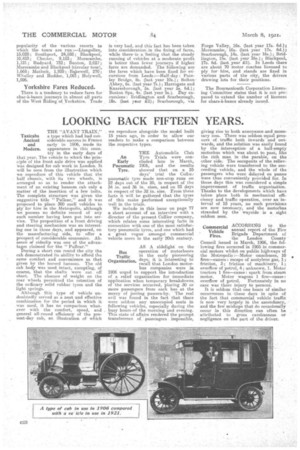LOOKING BACK FIFTEEN YEARS.
Page 22

If you've noticed an error in this article please click here to report it so we can fix it.
THE "AVANT TRAIN," Taxicabs a type which had had con Ancient siderable success in France and early in 1906, made its Modern, appearance in this coun• try in the early days of that year. The vehicle to which tke principle of the front axle drive was applied was designed for cab work in London. It will be seen from the illustration which we reproduce of this vehicle that the half chassis, with its two wheels, is arranged so as to render the attachment of an existing hansom cab only a matter of the insertion of a few bolts. The complete structure was given the suggestive title "Pullcar," mid it was proposed to place 300 such vehicles to ply for hire in the Metropolis, although we possess no definite record of any such number having been pat into service. The proposition of a front driving and steering mechanism was an interesting one in those days, and appeared, on the manufacturing side, to offer a prospect of considerable economies. Ab• sence of sideslip was one of the advantages claimed • for the " Pullcar."
During a short run round the city the cab demonstrated its ability to afford the same comfort and convenience as that given by the horsed hansom. The old cab body was used intact, excepting, of course, that the shafts were cut off short. The absence of weight on the rear wheels permitted the retention of the ordinary solid rubber tyres and the light springs.
Although this type of vehicle undoubtedly served as a neat and effective combination for the period in which it was used, it has no comparison whatever with the comfort, speed, and general all-round efficiency of the present-day cab, an illustration ofwhich we reproduce alongside the model built 15 years ago, in order to allow our readers to make a comparison between the respective types.
THE Automobile Club An Tyre Trials were con Early eluded late in March, Pneumatic 1906, and the results
Tyre. showed that on a 25 days' trial the Coll-Me pneumatic tyre made non-stop runs on 22 days out of the 25, ie respect of the 34 in. and 36 in. sizes, and on 23 days in respect of the 32 in. size. From these facts it will be gathered that the tyres of this make performed exceptionally -.yell in the trials.
We include in this issue on page 77 a short account of an interview with a director of the present Collier company, which relates some interesting facts in connection with one of the most satisfactory pneumatic tyres, and one whirls had a great vogue amongst commercial vehicle users in the earl 20th century.
AS A sidelight on the
Bus operation of motorbeses
Traffic in the early pioneering
Organization. days; it is interesting to
recall that London motor bus companies were in 1906 urged to support the introduction of a relief organization for immediate application when temporary breakdowns of the services occurred, placing 30 or more passengers from each bus at the mercy of jeering passers-by. The real evil was found in the fact that there were seldom any unoccupied seats in following vehicles, especially during the busy hours .of the morning and evening. This state of affairs rendered the prompt transference of passengers impossible, giving rise to both annoyance and monetary loss. There was seldom -equal pressure of traffic both inwards and outwards, and the solution was easily found by the interception of a half•empty motorbus which was about to pasS, like the rich man in the parable, on the other side. The occupants of the relieving vehicle Were transferred to the succeeding vehicle, and the whole of the passengers who were delayed en panne were thus conveniently provided for. In those days this was considered a simple improvement of traffic organization. Thanks to the developments which have taken place both in mechanical efficiency and traffic operation, over an 'interval of 15 years, no such provisions are now necessary, and the motorbus stranded by the wayside • is a sight seldom seen.
Commercial ACCORDING to the
Vehicle annual report of the Fire Brigadeepartment of
the London County Council issued in March, 1906, the following fires occurred in 1905 in commercial motors whilst on public highways of the Metropolis :—Motor omnibuses, 10 fires—causes: escape of acetylene gas, 1; friction, 3; friction of machinery, 1; overflow of petrol, 4; unknown, 1. Motor tractors 1 fire—cause: spark from steam motor. Motor wagons 1 fire—cause: overflow of petrol. Fortunately in no case was there injury to persons.
It is seldom that one hears of similar occurrences in -these days in spite of the fact that commercial vehicle traffic is now very largely in the ascendancy, and the few mishaps that do occasionally occur in this direction can often be attributed to gross carelessness or negligence on the part of the driver.
































